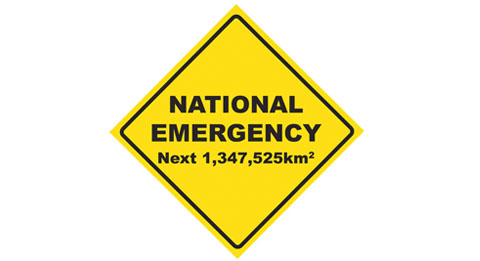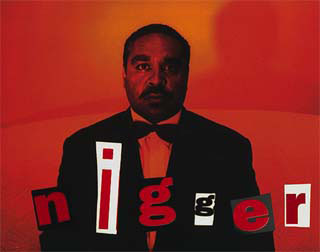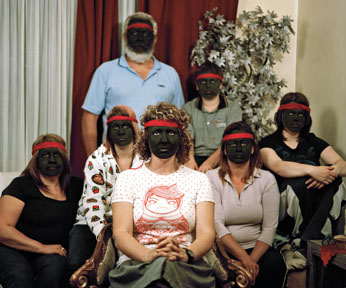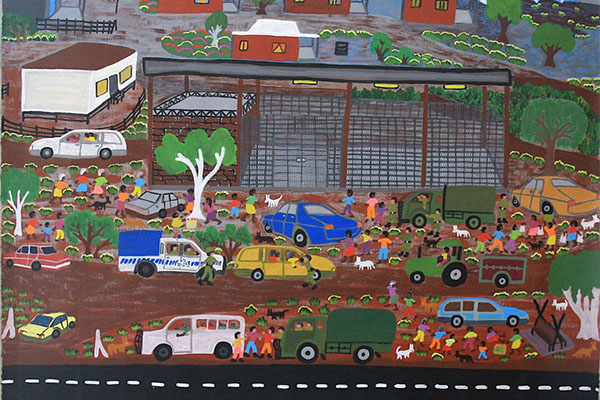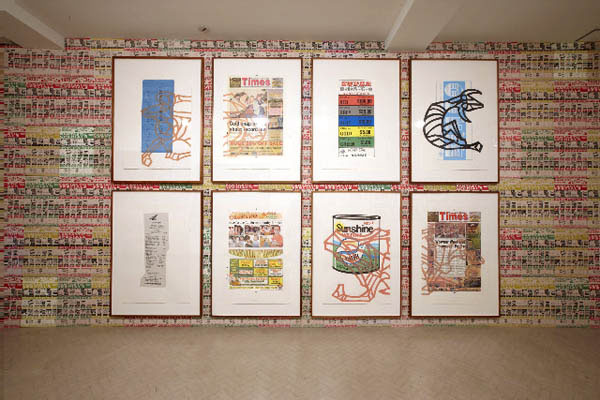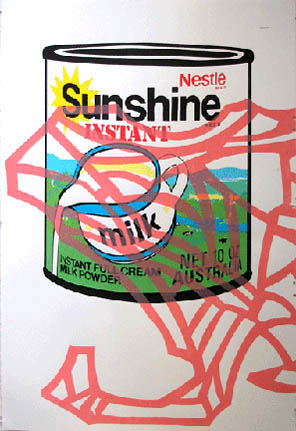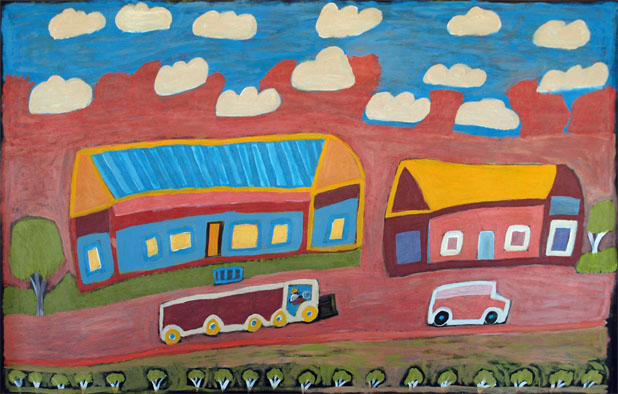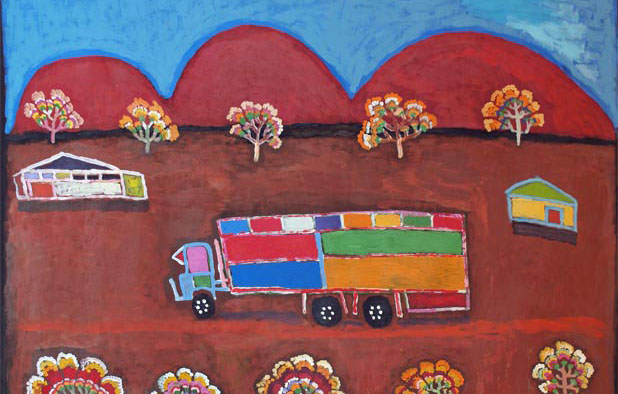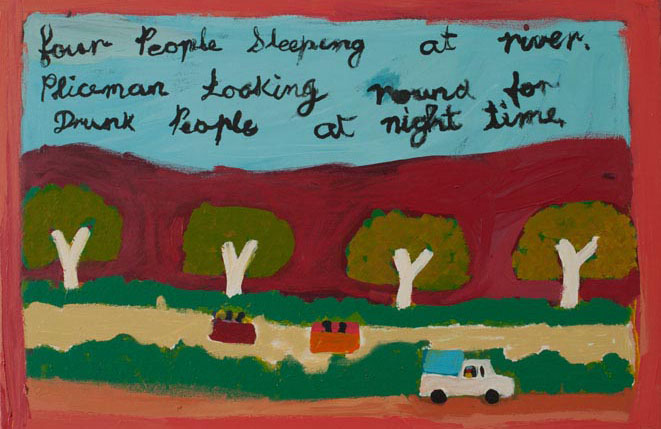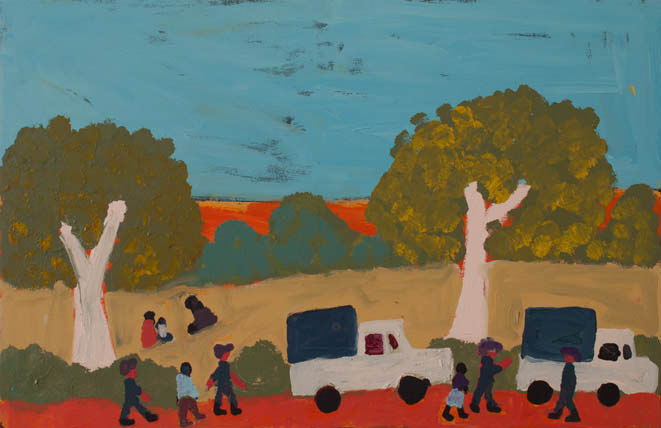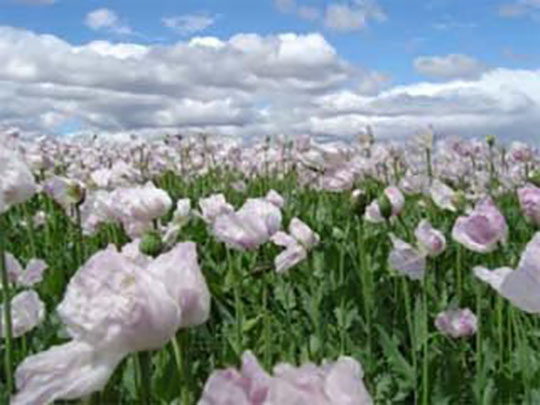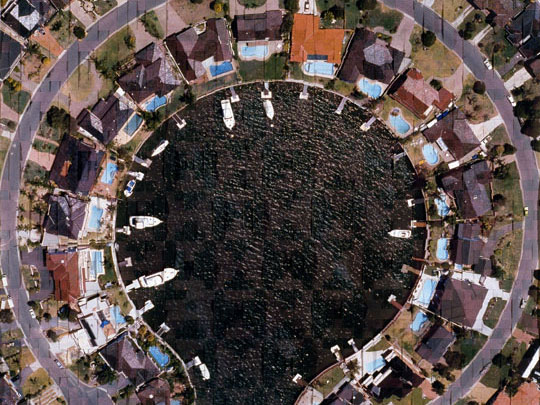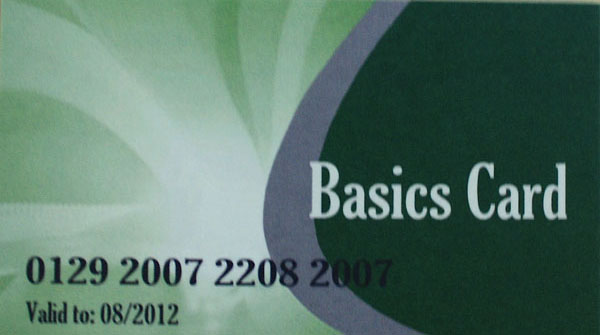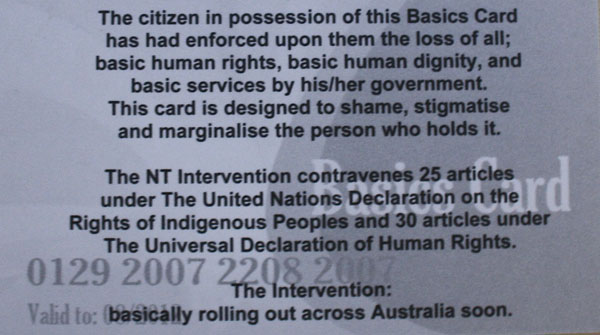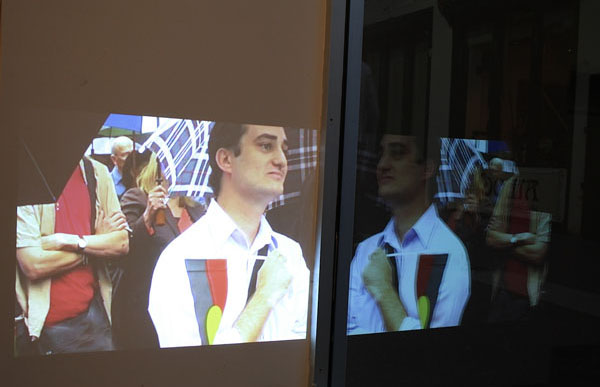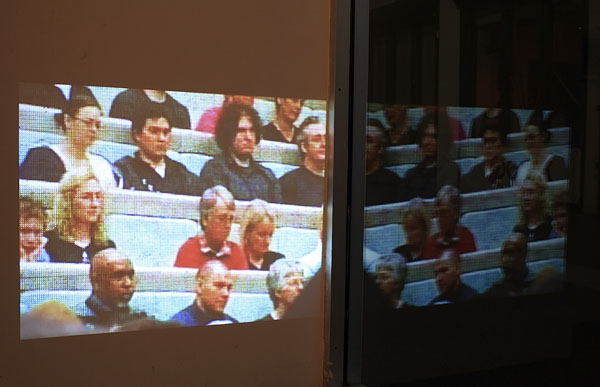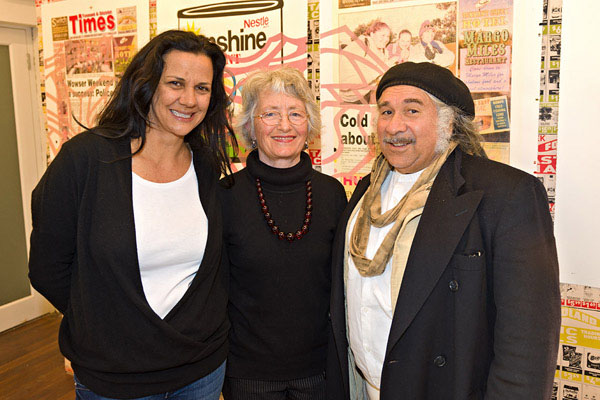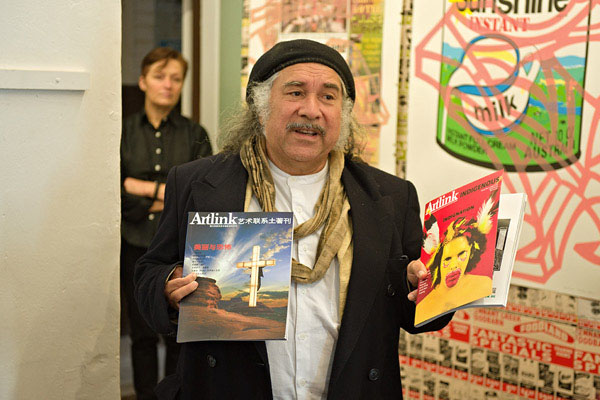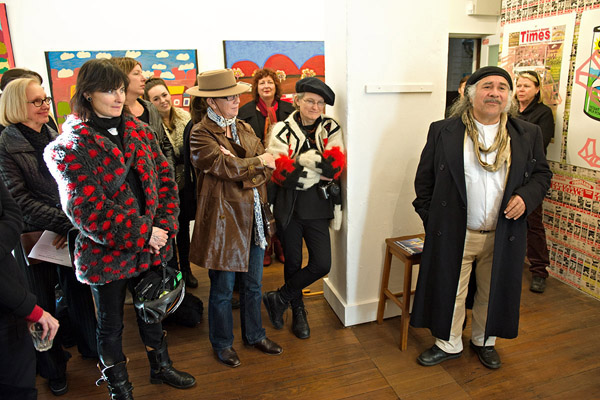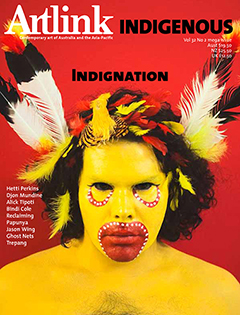
Ghost Citizens: Witnessing the Intervention. Curators Djon Mundine and Jo Holder — 21 June to 21 July 2012
Artists: Alison Alder, Bindi Cole, Fiona Foley, Dan Jones, Fiona MacDonald, Chips Mackinolty, Sally M Mulda, Amy Napurulla, Brendan Penzer, Michael Riley, Gordon Syron, Deborah Vaughan, Jason Wing
Exhibition extended due to overwhelming interest to Saturday 21 July 2012
Talks by Djon Mundine, Eva Cox and Paddy Gibson on Saturday 23 June and Hetti Perkins on Sunday 1 July at 3pm
Curator: Djon Mundine OAM with Jo Holder
Chips Mackinolty, National Emergency, 2007. Digital print
Jason Wing, End Restriction, 2012. Digital C Type Print, 29.7 x 42 cm
Ghost Citizens
I was told by a friend that Chinese people fear three dangers to their home — thieves, fire, and ghosts.
The Ngarrindjarri, at the mouth of the Murray River, called the first Europeans they saw Kraingkari (krink for short) rotting corpse. In their experience, after death the outer skin rots away taking away black skin leaving a pink-white layer of flesh. They saw them as having no colour, of being similar in appearance to rotting corpses of the dead, as ghosts.
Aboriginal people then became the ghosts either as victims of colonial massacres or as shadowy figures on the edge of the national psyche, neither really citizens nor aliens — ghost citizens who refuse to go away.
The word ‘intervention’ is popular in the art and architecture worlds, but in this context it condemns the Northern Territory Emergency Response (NTER), Australia’s ‘national emergency’ policy introduced in 2007. This punitive policy is at odds with international human rights conventions and the Racial Discrimination Act.
The exhibition Ghost Citizens: Witnessing the Intervention looks at this return to protectionist colonial policy and the wilful diminishing of an Indigenous participatory voice: the loss of citizenship rights, of the right to homelands and self-determination.
‘Ghost citizens’ follow us and infiltrate our daily lives. In a continent full of the ghosts and shadows of colonialism, the historical, social, and physical landscape is damaged. Each story is a ghost story loaded with shadows — a kind of scar story. Ghost Citizens is about the removal of citizens’ rights seen through the witnessing eye of 8 Aboriginal and 5 non-Indigenous artists, presented in two parts: documents and interventions, and the idea of bearing historical witness to evil or catastrophe.
Of the many forms of visual witnessing, from documentary to expressionism, the bedrock is the same quiet assertion: the language of artists working in remote communities, asserting their cultural strength. This is the language of refusal writ large. The other side of the coin is strategic activism. These shadows return us to heroic struggles like the 30-year campaign by the Aborigines Progressive Association to Claim Citizen Rights! It was not until the 1967 Referendum, that Aboriginal and Torres Strait Islander peoples could claim full citizenship.
Some artists, like Sally M. Mula paint from ground zero, the outskirts and town camps of Alice Springs, to make eye witness accounts — of semi-trailers bringing kit houses for white managers, of police in their new navy blue uniforms entering public spaces to crackdown on drinkers and incarcerate riverbed people as government mobs come and go and conditions worsen.
The Northern Territory Intervention began as a dramatic media stunt (military, boots, babies) to translate into a vote-winner for a conservative government: a tanks-and-all approach to addressing Aboriginal disadvantage. It damaged the lives of countless people. The cancelling of subsidised employment (Community Development Employment Projects) left many remote art centres without skilled staff (many of whom are important artists). The beginning of the horror coincided with Mulkun Wirrpanda’s important exhibition One Lore, Two Law, Outlaw: Dhakiyarr v the King at The Cross Art Projects. Chips Mackinolty’s banner-scaled National Emergency Next hung outside.
Deborah Vaughan’s documentary video, projected at foot level, shows the vast crowd in Martin Place, site of Sydney’s ‘Lest We Forget’ war memorial, gathered despite rain to witness the newly elected centre left Rudd Government’s gesture of reconciliation — the National Apology to Australia’s Indigenous Peoples and in particular the Stolen Generations (February 2008).
The government’s sorry business, however, began again when it just re-badged the Intervention with Orwellian titles, the first named ‘Closing the Gap’ and, when the sunset review clause kicked in mid-2012, as a Bill now before the Australian Senate named ‘Stronger Futures’ to extend some of the most controversial elements of the Intervention for the next decade — to any part of the country beginning with Toomelah and Bankstown in NSW. The dignity of Aboriginal people and the hope of millions of citizens is being trampled underfoot again.
Frantz Fanon wrote that colonialism and racism are forms of violence embedded in every facet of colonial cultural expression, so subtle and pervasive as to be invisible. To make his point he described the cruel disjunction of a black man (himself) watching the film Tarzan (1932) with a black audience in French colonised Martinique, and later watching the same film in a white audience in Paris.
In Michael Riley’s important series They Call Me Niiggaar (1995) the subject is actor David Prosser, while Bindi Cole portrays her father and family in blackface. The pigment they wear is, ironically, a high fashion cosmetic still named ‘nigger brown’ in 2011. Both artists convey the racist language of sneer and ridicule. The actor will always remain just a ‘nigger’, a shadow of white society; Cole’s family is not black enough. The irony is that in Riley’s work, the word Niigaar in Prosser’s own Gumbayngirr language means ‘a man, a person, a human being’.
Do Australians (and most countries in fact) live in a happy dreamlike anesthetised, sedated state ignoring the reality of history to avoid the trauma, truth, and guilt of the past? Fiona Foley’s poetic video Bliss (2006) showing fields of swaying poppies, belies the insidiousness of ghost histories of colonialism. She reinterprets the history of enforced opium addiction in the Queensland Aboriginal community in the 1850s. Just as in Fiona MacDonald’s woven print Log Cabin, James Cook Island (2005) the ghost-like head of a Wandjina spirit appears in the patchwork bliss of a sub-division in The Shire named after Captain Cook and the first devastating intervention.
The white man came and night entered our future with him. Our Council has asked the question since I was a boy: ‘What are the Huron to do?’
Sachem (elder of the Huron) in The Last of the Mohicans (1992, Director, Michael Mann)
Ghosts impart the curse of history. The Intervention is very unpopular with few positive results so far. Aboriginal community leaders who were not initially even consulted, need to be listened to about their particular priorities, ideas and solutions. The challenge is to create an economic basis for these remote communities — to strengthen what works like the art centres and homelands — and not relocate them off their traditional lands to live as outcast fringe dwellers on the margins of ‘growth centres’.
In the 2001 anime film Spirited Away, a child witnesses her parents self-transforming in ‘pigging out’ and falls into a land of ghosts that she can only escape and save her parents by responsibly moving to adulthood. In dealing with Australia’s national colonial past, non-Aboriginal Australians periodically approach a level of awareness that they are not living in Europe any more, that they are not living in a colony of Europe any more. We cannot blame the British any more. As each generation comes close to this point of responsibly dealing as adults with their history, they inexplicably fall back, recoiling almost in terror that they could be so independently human.
Djon Mundine OAM
Michael Riley, niigarr from the series They Call me Niigarr, 1995. High gloss inkjet print, 31 x 39.5 cm
Bindi Cole, Wathaurung Mob, 2008. Pigment on rag paper, 94 x 103 cm
Kylie Kemarre, The Intervention at Ahalpere Store on the Sandover Highway in the middle of the Utopia Community, January 2008.
Alison Alder, Intervention series, 2008. 8 prints (2 pairs) each print 76 x 112 cm Installation view.
Alison Alder, from Intervention series, 2008.
Amy Napurulla, Lhite – My Father’s Country, 2010. Acrylic on canvas 120 x 75 cm
Dan Jones, Utopia Loading Truck, 2009. Acrylic on canvas 120 x 90 cm
Sally M Mulda, Policemen, 2012. Acrylic, 90 x 60 cm
Sally M Mulda, Husband and Wife Drunk, 2012. Acrylic on canvas 90 x 60 cm
Fiona Foley, Bliss, 2006. Digital video with sound, 11 minutes
Fiona MacDonald, Log Cabin – James Cook Island, 2005. Woven archival digital print, 80 x 63 cm
Brendan Penzer, Basics Card, 2011 (front). Printed card
Brendan Penzer, Basics Card, 2011 (verso)
Deborah Vaughan, Sorry Day, 2008. Video installation
Deborah Vaughan, Sorry Day, 2008. Video installation
Acknowledgements
Thanks to: speakers Eva Cox, Paddy Gibson, Craig Longman at Jumbunna Indigenous House of Learning at University of Technology, Sydney and Hetti Perkins, resident curator for Bangarra Dance Theatre. Organisations: Tantengere Artists, representing urban and regional artists from 18 Alice Springs Town Camp communities; Asialink; Stills Gallery and Michael Riley Foundation; Nellie Castan Gallery; James Baker Art Dealer; Art Atrium and Hazelhurst Art Gallery. Special thanks to Teena McCarthy and Brendan Penzer for their 2011 bell-wether exhibition iNTvervention Intervention, presented at the vanishing point. Interns: Sofia Freeman and Jeremy Millsap.
This video presents excerpts from talks opening Ghost Citizens: Witnessing the Intervention at The Cross Art Projects, Sydney, 23 June 2012:
Digital video with sound, 11 minutes. Camera and editors Sabina Kacha and Hans Mauve.
Speakers:
– Jo Holder, Director of The Cross Arts Projects
– Djon Mundine OAM, exhibition co-curator
– Paddy Gibson, Jumbunna Indigenous House of Learning, University of Technology, Sydney
– Eva Cox, Jumbunna Indigenous House of Learning, University of Technology, Sydney
Ghost Citizens: Witnessing the Intervention. Opening.
Ghost Citizens: Witnessing the Intervention. Opening.
Ghost Citizens: Witnessing the Intervention. Opening.
Ghost Citizens: Witnessing the Intervention. Opening.
Eva Cox, Djon Mundine (curator) and Paddy Gibson; opening speakers on 23 June 2012.
Roy Mundine , Djon Mundine and Annemarie Dalziel.
Notes
The Stronger Futures legislation was opposed by Aboriginal people across the Northern Territory and civil society across the nation. The Government refused to listen. On the opening night of the Sydney Biennale the legislation passed (at 2am in an empty chamber.) They rejected the advice of Parliament’s own Joint Committee on Human Rights demanding the bills be subjected to a human rights test.
The former Prime Minister Malcolm Fraser, the Yolngu Nations Assembly, Central Land Council, National Congress of Australia’s First People, the UN High Commissioner for Human Rights Pacific, Amnesty International, Human Rights Law Centre, Australian Council of Social Services, Aboriginal Medical Service NT and Australian Indigenous Doctors Assoc are united in their criticism of the Australian Federal Government’s Stronger Futures in the Northern Territory Bill, 2012. They say there is little evidence of how the Intervention has met any of its vague aims. See http://www.comlaw.gov.au/Details/C2011B00242
Take Action
The Intervention (Stronger Futures Act) is also now extended to Bankstown in Sydney and 5 other areas in Australia.
http://stoptheintervention.org/
http://www.greenleft.org.au/node/51259
Download
The Yolngu Nations Assembly, Statement regarding Australian Federal Government Stronger Futures Bills and Northern Territory Policies, 24 April 2012: ‘[We] reject the Stronger Futures and call on the Senate to discard these bills in full. We have clearly informed you that we do not support the legislation.’ > Download PDF
Senate Committee review of Stronger Futures in the Northern Territory, Senate Standing Committees on Community Affairs, 14 March 2012. > Download PDF
Launch by Hetti Perkins, resident curator Bangarra Dance Theatre, of Artlink, ‘Indigenous: Indignation’, The Cross Art Projects, 1 July 2012. http://artlink.com.au/issues/3220/artlink-indigenous-indignation/

